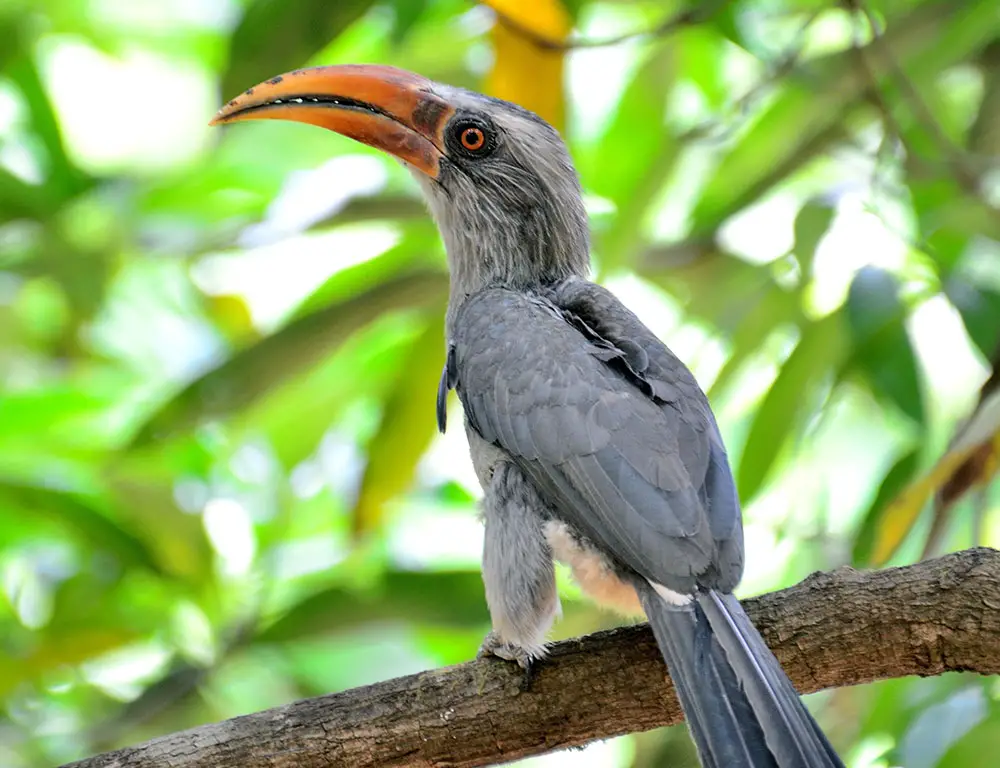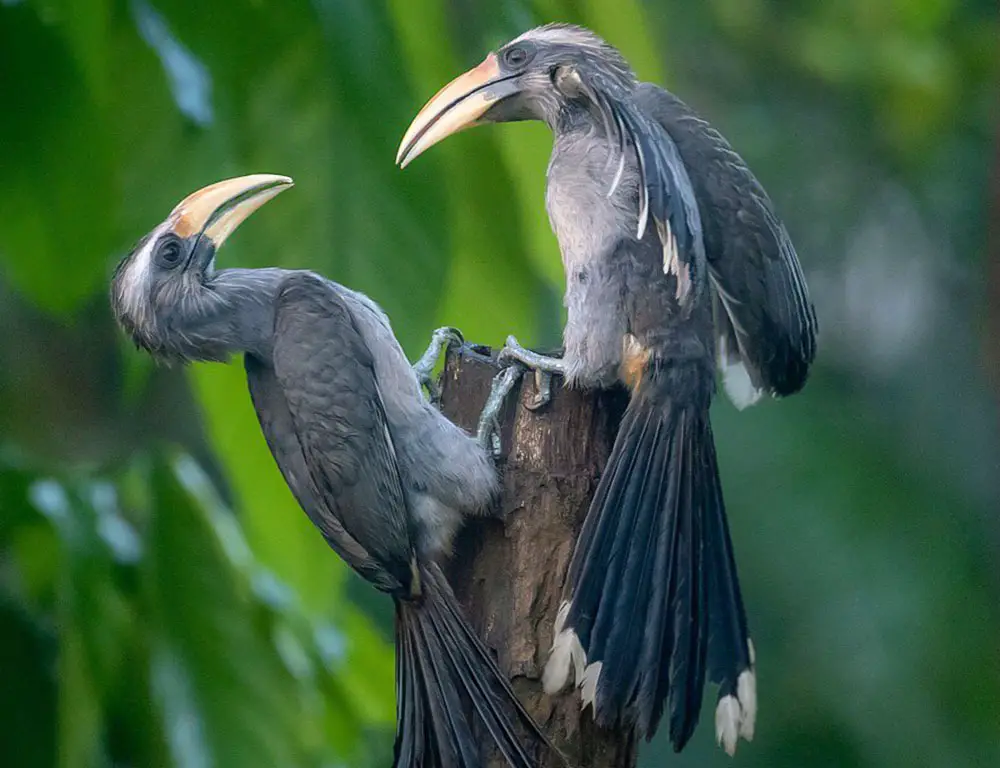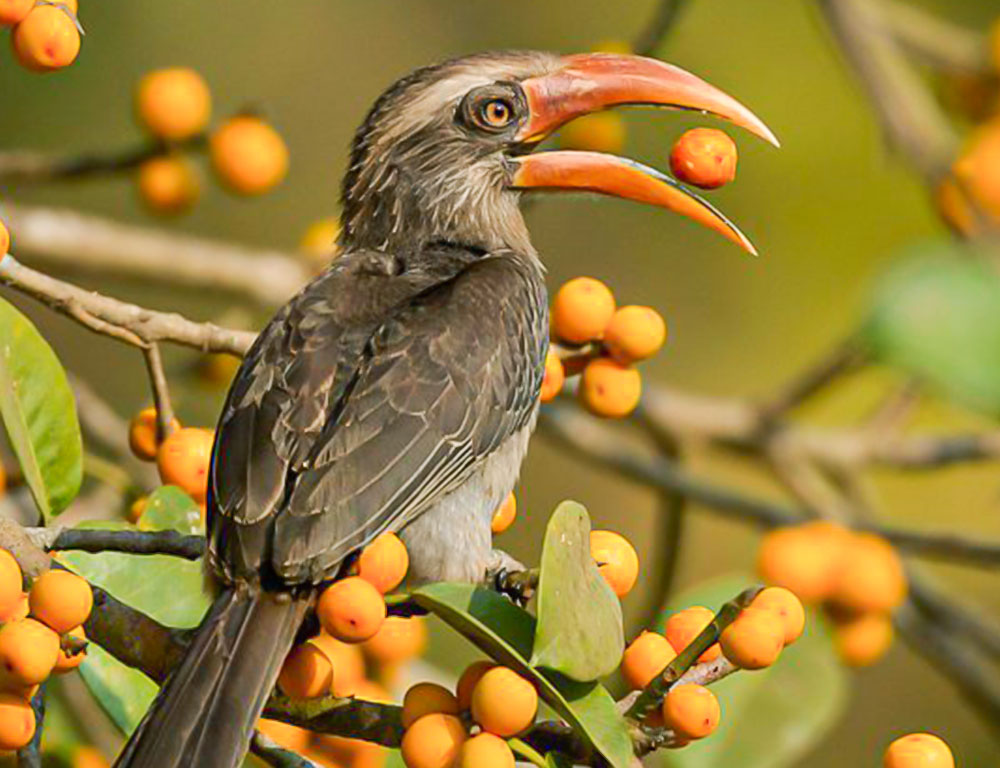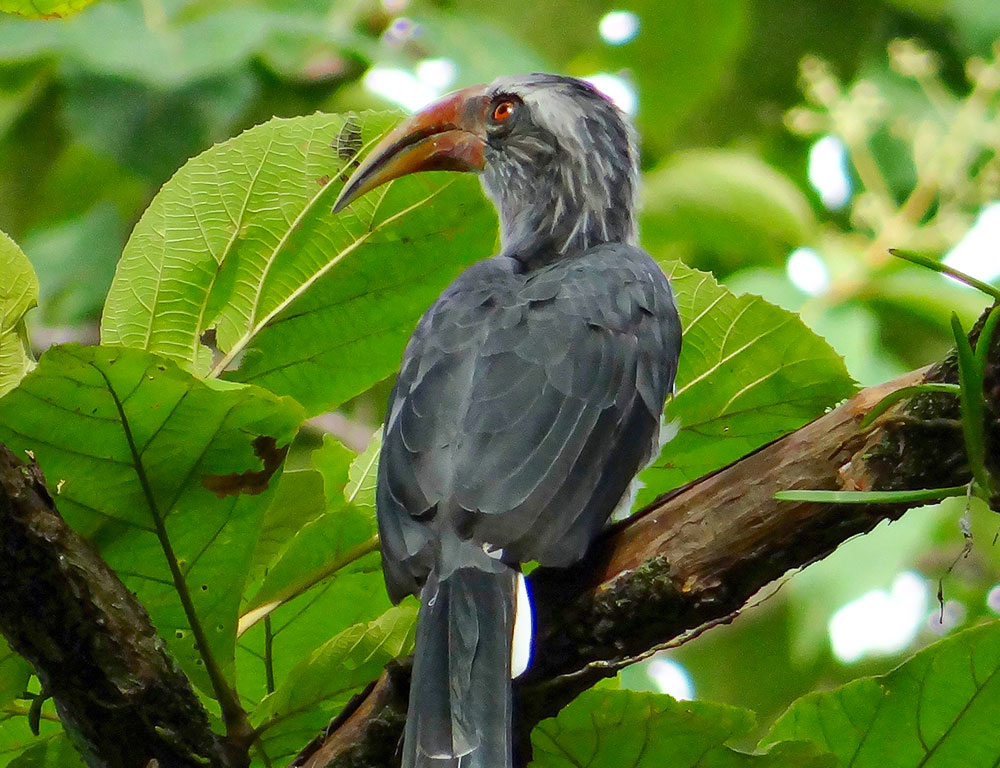In the rich tapestry of avian diversity, the Malabar Grey Hornbill emerges as a captivating figure, capturing the imagination with its striking appearance and fascinating behaviors.
Endemic to the Western Ghats of India, this unique hornbill species embodies a blend of natural artistry and evolutionary ingenuity. Its distinctive casque, splendid plumage, and peculiar nesting habits set it apart in the avian world.
Beyond its aesthetic allure, the Malabar Grey Hornbill plays a vital ecological role as a frugivore, aiding in seed dispersal and contributing to the regeneration of forest ecosystems.
With its commitment to family care and ecological stewardship, this remarkable bird is a testament to the intricate interplay between nature’s wonders and evolutionary adaptations.
Physical Characteristics of Malabar Grey Hornbills

The Malabar Grey Hornbill (Ocyceros griseus) is a captivating bird species native to the Western Ghats and associated hills of southern India.
Let’s explore its distinct physical characteristics:
Size
The Malabar Grey Hornbill typically measures about 45 to 58 centimeters (18 to 23 inches), making it a medium-sized bird.
Coloration
As its name suggests, the Malabar Grey Hornbill predominantly features grey plumage, although there may be variations in shade among individuals. This grey coloration provides effective camouflage in its forest habitat.
Beak
One of the most striking features of the Malabar Grey Hornbill is its large, downward-curved beak. Unlike many other hornbill species, it lacks the prominent casque, or hollow structure, on top of the beak. The beak is typically yellowish-grey in color.
Facial Features
- Skin Patches: Surrounding the eyes are patches of bare skin that can change color. These patches may range from pale blue to dark azure, adding an element of visual interest to the bird’s face.
- Orbital Ring: Each eye is encircled by a distinctive white orbital ring, which contrasts against the grey feathers and enhances the bird’s appearance.
Sexual Dimorphism
- Males: Male Malabar Grey Hornbills often exhibit brownish-grey wings with black primaries, contributing to subtle differences in overall plumage compared to females.
- Females: Females typically have more whitish-grey underparts and may have tail feathers tipped in white. These differences allow for visual identification of the sexes, although they share many physical traits.
Feet and Claws
The Malabar Grey Hornbill has strong feet with sharp claws. These adaptations enable the bird to cling securely to tree trunks or branches, supporting its arboreal lifestyle and foraging behaviors.
Habitat and Distribution of the Malabar Grey Hornbill

The Malabar Grey Hornbill, native to India, thrives in the lush landscapes of the Western Ghats, demonstrating remarkable adaptability to various environmental conditions.
Here’s a deeper look into their habitat and distribution:
Preferred Habitat
Malabar Grey Hornbills are commonly found in moist deciduous forests, where they can find suitable nesting sites and ample food sources.
However, they are also known to inhabit plantations and gardens, showcasing their ability to adapt to human-altered landscapes.
Distribution
These birds are non-migratory, meaning they remain within a particular geographical area. Their range spans from North Kerala to South Goa along the western coast of India.
They are primarily found in areas with altitudes ranging from sea level up to 1400 meters.
Population Estimates
According to BirdLife International data, the global population of Malabar Grey Hornbills is estimated to be between 10,000 and 19,999 mature individuals. While not significantly large globally, the population is considered stable.
Nesting Habits
Malabar Grey Hornbills utilize tree cavities for nesting. The female enters the cavity and seals herself inside using her droppings mixed with food particles, leaving only a tiny aperture open for receiving food from her mate.
This unique nesting behavior highlights their dependence on suitable habitat features for reproduction.
Ecological Role
These hornbills play a crucial role in forest ecosystems as seed dispersers, contributing to the maintenance of biodiversity.
Their reliance on forest habitats underscores the importance of preserving these ecosystems for the survival of the hornbills and numerous other species.
Threats
Deforestation significantly threatens the Malabar Grey Hornbill and its habitat. Loss of natural habitats due to human activities can disrupt their symbiotic relationship with the environment, leading to population declines and increased vulnerability to extinction.
Behavior and Feeding Habits of Malabar Grey Hornbills

The behavior and feeding habits of the Malabar Grey Hornbill indeed offer fascinating insights into its life in the forests of southern India. Here’s a closer look at its behaviors:
Feeding Habits
- Frugivorous Diet: The Malabar Grey Hornbill primarily feeds on fruits from various trees, but it is also opportunistic and consumes small mammals, birds, insects, and reptiles when available.
- Adaptability: These hornbills demonstrate remarkable adaptability in their feeding habits. During fruiting seasons in evergreen forests, they prefer wild fruits like figs and berries. In lean seasons or areas with less fruit availability, such as deciduous forests or plantations, they shift their diet to insects and other small animals.
Cooperative Feeding Behavior
Malabar Grey Hornbills exhibit cooperative feeding behavior, where pairs work together to hunt. One bird may distract potential prey with loud wing fluttering while the other swoops in for an easy catch. This cooperative strategy enhances their hunting success and efficiency.
Breeding Behavior
During the breeding season, the female seals herself inside a tree cavity using a mixture of droppings and food particles. The male then provides food to the female through a small opening until the chicks hatch.
This behavior showcases the male’s dedication to providing for his partner and offspring.
Conservation Status of the Malabar Grey Hornbill

The Malabar Grey Hornbill, classified as “Least Concern” on the IUCN Red List, faces significant conservation challenges despite its current status.
Here’s an overview of the threats and conservation efforts related to this species:
Habitat Loss
- Impact: Habitat loss is the most significant threat to Malabar Grey Hornbills, with an estimated effect of 60%. Deforestation, primarily for agriculture, logging, and urbanization, reduces the availability of suitable nesting and foraging habitats for these birds.
- Conservation Action: Conservation efforts aim to mitigate habitat loss by establishing protected areas, restoration projects, and community-based conservation initiatives. Land-use planning and sustainable forestry practices also play a crucial role in conserving critical habitats for the species.
Hunting
- Impact: Hunting poses a significant threat to Malabar Grey Hornbills, with an estimated effect of 30%. While not as widespread as habitat loss, hunting for meat, traditional medicine, and cultural practices can still harm local populations.
- Conservation Action: Efforts to address hunting threats include strengthening law enforcement, raising awareness about the importance of conserving hornbill species, and engaging with local communities to promote sustainable livelihood alternatives.
Conservation Measures
Despite being classified as “Least Concern,” continued conservation efforts are essential to ensure the long-term survival of Malabar Grey Hornbills.
Key conservation measures include habitat protection, restoration of degraded habitats, establishment of conservation corridors, monitoring of populations, and research to understand the species’ ecology and behavior better.
Public Awareness
Raising public awareness about conserving Malabar Grey Hornbills and their habitats is critical.
Educating local communities, policymakers, and the general public about the ecological significance of these birds can foster more significant support for conservation initiatives.
FAQs
Are Malabar Grey Hornbills territorial birds?
Malabar Grey Hornbills are known to defend their nesting sites and foraging territories from intruders, particularly during the breeding season.
What is the reproductive cycle of Malabar Grey Hornbills?
The reproductive cycle of Malabar Grey Hornbills typically involves courtship, nesting, egg-laying, incubation, and fledging. The female seals herself inside a tree cavity during incubation, while the male provides food for both the female and the chicks.
How do Malabar Grey Hornbills communicate?
Malabar Grey Hornbills communicate with resonant ‘kuk-kuk-kuk’ calls, which can carry long distances, facilitating social interactions and territorial defense.
Do Malabar Grey Hornbills engage in social behaviors?
While they are primarily seen in pairs during the breeding season, Malabar Grey Hornbills may also form small groups or flocks outside of the breeding period, engaging in social interactions such as vocalizations and cooperative foraging.
How do Malabar Grey Hornbills contribute to forest ecosystems?
Malabar Grey Hornbills play a crucial role in forest ecosystems as seed dispersers. By consuming fruits and excreting seeds in different locations, they aid in the regeneration and diversity of plant species.
Conclusion
The Malabar Grey Hornbill emerges as a remarkable and indispensable component of its ecosystem, characterized by unique physical attributes and intriguing behaviors.
Its frugivorous diet, especially its affinity for figs, contributes significantly to seed dispersal and forest regeneration.
The bird’s reproductive behavior, notably the female’s confinement within a tree cavity during incubation, underscores its remarkable parenting and vulnerability.
However, the species faces pressing threats from deforestation and human settlement expansion. By bolstering conservation efforts, we can safeguard these magnificent creatures and preserve biodiversity within our ecosystems.
Through continued research and heightened awareness, we can pave the way for a secure environment conducive to the thriving existence of future generations of Malabar Grey Hornbills, enriching our appreciation for avian diversity worldwide.